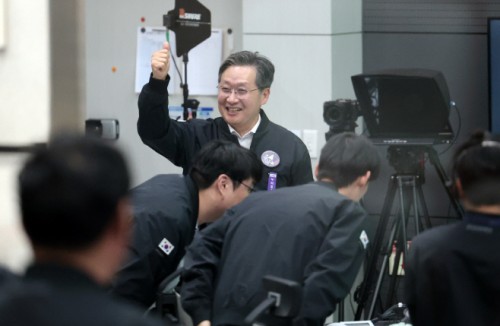 |
| Yoon Young-bin, head of the Korea Aerospace Administration, visits the launch control center at the Naro Space Center in Goheung on Nov. 27 to congratulate staff after the successful fourth launch of the Nuri rocket. / Korea Aerospace Research Institute |
Korea’s fourth Nuri rocket successfully lifted off at 1:13 a.m. on Nov. 27, completing all phases of launch and satellite deployment without issue.
The Korea Aerospace Administration and the Korea Aerospace Research Institute (KARI) officially announced the mission’s success shortly after liftoff.
According to KARI’s preliminary analysis of the rocket’s telemetry data, Nuri placed the third Next-Generation Medium Satellite and 12 CubeSats into their target orbit at 600 kilometers, achieving a stable separation and insertion for all 13 satellites.
Nuri separated its first-stage engine at 122.3 seconds after launch at an altitude of 65.7 kilometers, then ignited its second-stage engine. At 230.2 seconds, the rocket jettisoned its fairing at approximately 211 kilometers. The third-stage engine ignited at 263.1 seconds at 263 kilometers, and the vehicle reached its target altitude of 600 kilometers at 741.2 seconds.
After entering the designated orbit, the rocket stabilized its attitude before separating the Next-Generation Medium Satellite No. 3 at 601.3 kilometers at 790.9 seconds. It then released the remaining 12 CubeSats sequentially between 813.6 and 914.4 seconds, completing the deployment. The 601.3-kilometer insertion altitude met the mission’s success criteria, which allowed for a margin around the intended 600-kilometer orbit.
At around 1:55 a.m., the main payload successfully made first contact with the ground station at Korea’s King Sejong Station in Antarctica, confirming the deployment of its solar panels and overall normal status. The 12 secondary CubeSats will undergo communications checks according to each satellite’s transmission schedule.
Yoon Young-bin, head of the Korea Aerospace Administration, said the government plans two more Nuri launches by 2027 while simultaneously pursuing development of a next-generation launch vehicle with greater performance, aiming to further strengthen Korea’s space capabilities.
Most Read
-
1
-
2
-
3
-
4
-
5
-
6
-
7





















